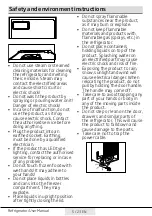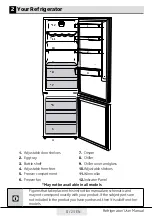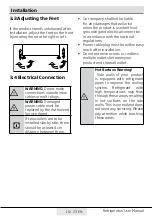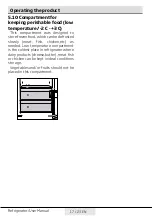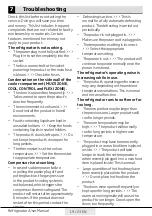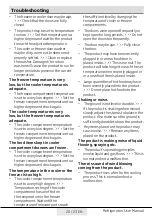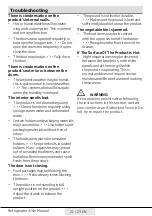
19 / 23 EN
Refrigerator/User Manual
7
Troubleshooting
Check th
i
s l
i
st before contact
i
ng the
serv
i
ce. Do
i
ng so w
i
ll save you t
i
me
and money. Th
i
s l
i
st
i
ncludes frequent
compla
i
nts that are not related to faulty
workmansh
i
p or mater
i
als. Certa
i
n
features ment
i
oned here
i
n may not
apply to your product.
The refrigerator is not working.
t
The power plug is not fully settled. >>>
Plug it in to settle completely into the
socket.
t
The fuse connected to the socket
powering the product or the main fuse
is blown. >>> Check the fuses.
Condensation on the side wall of the
cooler compartment (MULTI ZONE,
COOL, CONTROL and FLEXI ZONE).
t
The door is opened too frequently >>>
Take care not to open the product’s
door too frequently.
t
The environment is too humid. >>>
Do not install the product in humid
environments.
t
Foods containing liquids are kept in
unsealed holders. >>> Keep the foods
containing liquids in sealed holders.
t
The product’s door is left open. >>> Do
not keep the product’s door open for
long periods.
t
The thermostat is set to too low
temperature. >>> Set the thermostat
to appropriate temperature.
Compressor is not working.
t
In case of sudden power failure
or pulling the power plug off and
putting back on, the gas pressure
in the product’s cooling system is
not balanced, which triggers the
compressor thermic safeguard. The
product will restart after approximately
6 minutes. If the product does not
restart after this period, contact the
service.
t
Defrosting is active. >>> This is
normal for a fully-automatic defrosting
product. The defrosting is carried out
periodically.
t
The product is not plugged in. >>>
Make sure the power cord is plugged in.
t
The temperature setting is incorrect.
>>> Select the appropriate
temperature setting.
t
The power is out. >>> The product will
continue to operate normally once the
power is restored.
The refrigerator’s operating noise is
increasing while in use.
t
The product’s operating performance
may vary depending on the ambient
temperature variations. This is normal
and not a malfunction.
The refrigerator runs too often or for
too long.
t
The new product may be larger than
the previous one. Larger products will
run for longer periods.
t
The room temperature may be
high. >>> The product will normally
run for long periods in higher room
temperature.
t
The product may have been recently
plugged in or a new food item is placed
inside. >>> The product will take
longer to reach the set temperature
when recently plugged in or a new food
item is placed inside. This is normal.
t
Large quantities of hot food may have
been recently placed into the product.
>>> Do not place hot food into the
product.
t
The doors were opened frequently or
kept open for long periods. >>> The
warm air moving inside will cause the
product to run longer. Do not open the
doors too frequently.

